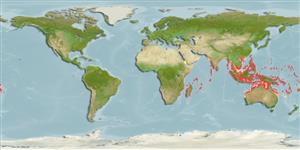Common names from other countries
Environment: milieu / climate zone / depth range / distribution range
بوم شناسي
دريايي; آب شيرين; لب شور نزديك كف زي; دريا كوچ (Ref. 51243). Tropical; 22°N - 27°S
Indo-Pacific: widespread in the tropical Indian Ocean and western Pacific. Known in Australia only from streams in the Kimberley regions of northern western Australia. Africa: widespread but relatively uncommon along east and southeast African coast and Madagascar (Ref. 7248, 52193). Mozambique; Lower Zambezi River (Ref. 39494). Most easily confused with Anguilla obscura and the surest way to distinguish them is by the count of vertebrae (Ref. 9828).
Size / Weight / سن
Maturity: Lm ? range ? - ? cm
Max length : 123 cm TL جنس نر / بدون خواص جنسي; (Ref. 6371); common length : 65.0 cm TL جنس نر / بدون خواص جنسي; (Ref. 2871); بيشينه سن گزارش شده: 20 سال ها (Ref. 48660)
خارهاي باله پشتي (کل) : 0; شعاع نرم باله پشتي (کل) : 240 - 245; خارهاي باله مخرجي: 0; شعاع نرم باله مخرجي: 200 - 220; مهره ها: 105 - 115.
Migratory species which breeds in the ocean (Ref. 52331, 79840). Lives in fresh water areas as an adult, in estuaries and seas as young (Ref. 12693). Descends to the sea to spawn. Inhabits freshwater streams and pools, preferring marshy habitats (Ref. 41236). Found in rivers and creeks, commonly over rock bottoms and in deeper pools. Seldom occurs in large rivers (Ref. 6028). Restricted to lowland (coastal) reaches of river systems (Ref. 7248). Feeds on small fishes, crustaceans and mollusks. Reported to breed east of Madagascar; the south equatorial current probably carries the eel larvae and elvers towards the east coast of Africa where local coastal currents guide the elvers to suitable rivers which they invade and they stay there until sexually mature, when they return to their breeding grounds (Ref. 13337). Caught with various types of nets. Sometimes used in the aquarium trade (Ref. 6028).
Life cycle and mating behavior
Maturities | تولید مثل | Spawnings | Egg(s) | Fecundities | توزاد ( لارو)
Kottelat, M., 2013. The fishes of the inland waters of Southeast Asia: a catalogue and core bibliography of the fishes known to occur in freshwaters, mangroves and estuaries. The Raffles Bulletin of Zoology 2013 (Suppl. 27):1-663. (Ref. 94476)
وضعيت در فهرست قرمز IUCN (Ref. 130435)
CITES (Ref. 128078)
Not Evaluated
خطر برای انسان ها
Harmless
استفاده انسانی
ماهي گيري – شيلات: ارزش تحاري اندك
ابزارها
گزارش های ويژه
بارگيری XML
منابع اينترنتي
Estimates based on models
Preferred temperature (Ref.
115969): 26.5 - 29.1, mean 28.3 (based on 1098 cells).
Phylogenetic diversity index (Ref.
82804): PD
50 = 0.5000 [Uniqueness, from 0.5 = low to 2.0 = high].
Bayesian length-weight: a=0.00076 (0.00037 - 0.00155), b=3.17 (3.00 - 3.34), in cm Total Length, based on LWR estimates for this Genus-body shape (Ref.
93245).
Trophic level (Ref.
69278): 3.6 ±0.50 se; based on food items.
جهندگی (Ref.
120179): پايين ، كم, كمينه زمان لازم براي دو برابر شدن جمعيت 5/4 – 14 سال (tmax=20).
Fishing Vulnerability (Ref.
59153): High to very high vulnerability (74 of 100).
